Short Term Groundcovers for Hot, Dry, Deer-Prone Areas
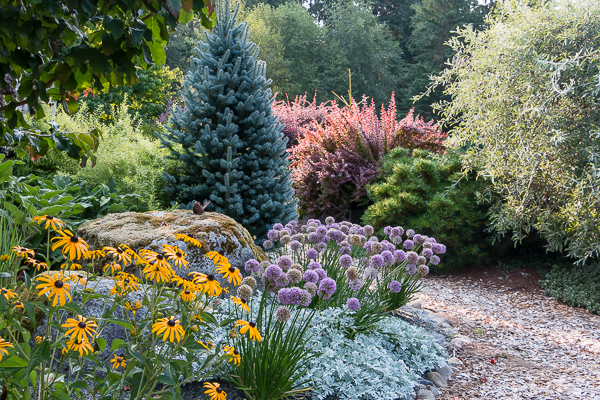
Generally I'm not a huge fan of groundcovers. While they do suppress weeds they also prevent me adding soil amendments such as compost and in some case they are downright thugs, covering every spare inch of ground and smothering everything in sight! Some of those thugs are also very difficult to remove as they grow adventitious roots wherever their stems touch the ground, forming dense mats.
There are times, however, when a short term bare-earth-covering plant might be useful. Something that is inexpensive, grows quickly yet can be removed with minimal effort when it is no longer needed. For example you might need to:
- Cover the expansive bare ground between newly planted, immature shrubs as a short-term weed suppressant (a much better solution than spacing the shrubs too close for instant impact)
- Decide what you really want long term and need to suppress weeds while you're still planning and researching
- Stretch your budget by covering a lot of ground cheaply
I've had all those scenarios yet also have to select plants that are
- Drought tolerant (I don't have an irrigation system)
- Deer-resistant
- Rabbit-resistant
- Happy in full sun
Over time I've narrowed my choices down to a few annuals and perennials that have proven reliable and look fabulous. In fact, many are now such firm favorites that I deliberately leave space for them in my summer designs, so I thought they'd be worth sharing with you all.
Note that I live in Duvall, WA, which is supposed to be USDA zone 7 but I'm sure I'm a step colder and assume 6b. Some of these plants that I consider annuals may well overwinter easily for you if your climate is more temperate and your winter soils drier.
Annuals
Sweet alyssum (Lobularia maritima)
I planted these in late April and they are STILL blooming in mid-August! I buy them as 4" plants and tuck them alongside my front path so that I can enjoy their sweet fragrance and simple, frothy look. Each little 4" plant grows to cover an area approximately 12" square. They never receive supplemental water, are completely ignored by deer and although the rabbits were a real problem this year, they never touched these.
Occasionally this will overwinter or re-seed itself but I generally assume I need to re-plant in spring.
Design tip: The growth is loose enough that stout, taller perennials such as seaholly (Eryngium) or tall verbena (Verbena bonariensis) can grow through them creating a delightful multi-layered effect.
Variety tip: newer, larger varieties are not as drought tolerant as the species.
Licorice plant (Helichrysum petiolare)

Petite licorice, as the name suggests, has a finer leaf texture than the regular licorice plant and is also smaller in size overall
This is my favorite foliage groundcover for hot, dry sites. An annual for me, this is one hard-working little plant with a big attitude. Each 4" pot planted in spring grows to fill an area up to 48" x 48" by the end of summer. I did notice the rabbits nibbling a few stems early in the season but the plants are so robust that they recovered easily.
Design tip: Looks fabulous mingling with other fine textures in contrasting colors e.g. Arkansas blue star (Amsonia hubrichtii). Or pair with other plants in shades of silver and blue for a shimmery monochromatic design.
Wormwood (e.g. Artemisia 'Silver Bullet')
 While there are similar but perennial forms of low growing wormwood e.g. Silver Brocade, the annual varieties are lower maintenance since they don't bloom. That's a bonus since one needs to cut off the flowering stalks to maintain the nice compact growth. The felted silver foliage is absolutely stunning.
While there are similar but perennial forms of low growing wormwood e.g. Silver Brocade, the annual varieties are lower maintenance since they don't bloom. That's a bonus since one needs to cut off the flowering stalks to maintain the nice compact growth. The felted silver foliage is absolutely stunning.
I've grown both Quicksilver and Silver Bullet (above) and they are very similar in habit although Silver Bullet seems to be a little more manageable at ~ 24-30" wide as opposed to Quicksilver which was at least 48".
My delinquent rabbits even had a go at this in spring but the plants recovered and look really great now as you can see.
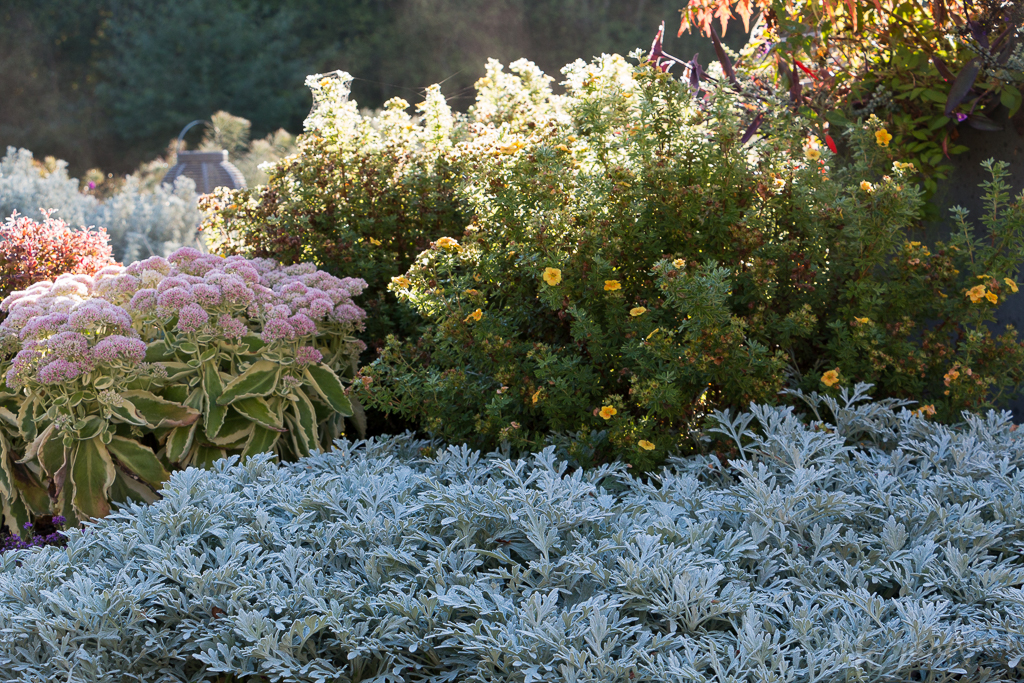
Quicksilver wormwood weaves between young shrubs and perennials, smothering out opportunistic weeds and knitting the plants together. (This was just ONE plant!)
Design Tip: use these to weave between immature shrubs.
Perennials
Santa Barbara Daisy, fleabane (Erigeron k. 'Profusion')
My garden is borderline hardy for this daisy – again, most likely due to my wet winter soils rather than cold temperatures, but even if the parent plant struggles to come back, with good fortune it will have self-seeded itself into various nooks and crannies to create a charming old-fashioned daisy meadow. The rabbits really gave this a tough time in spring – far worse than usual and I did have to resort to spraying a few of the most ravaged plants with rabbit repellent but the daisy eventually won and is now pushing out dozens of flowers every day. This never receives supplemental water.
Design tip: I fell in love with this scene at Haddon Hall, Derbyshire, UK where it has self-seeded in the cracks of weathered stone steps. Or try it tucked into planting pockets in stone walls.
Lemon thyme (Thymus citriodus)
The only negative with this perennial herb is that slugs are attracted to it in spring, but they eventually seems to tire of it and this tough little groundcover bounces right back. It quickly forms a tight mat of weed smothering, fragrant foliage. Other carpeting thyme varieties are also ideal for hot, dry spots but not all are edible.
Design tip: grow it close to the kitchen for easy pickings
Lambs Ears (Stachys byzantina)
Lambs ears brings out everyone's inner child – who can resist stopping to stroke these velvety leaves? These form a dense carpet and positively laugh at deer and rabbits. I choose to cut off the flowering stalks as they detract from the foliage in my opinion.
These are slightly higher maintenance than other groundcovers suggested in this post. They benefit from old grungy leaves been pulled out from underneath the fresh ones to reduce fungal infection, and after a log wet winter I find it best to cut the otherwise evergreen foliage down since it's looking pretty shabby at that point. Fresh leaves quickly appear and cover up the evidence though.
Design tip: these need tough companions such as robust conifers or shrubs. (They look fabulous beneath the deep purple leaves of my Red Dragon corkscrew hazel). More delicate stems of perennials will likely get smothered if crowd control is not managed.
Sedums and succulents

Sedum r. 'Angelina' creates a vibrant golden carpet in between confers, grasses, perennials and shrubs in a friends garden.
I've left the most obvious choice until last. Succulents are perhaps the default choice for hot dry locations and certainly they are rabbit and drought resistant. Deer-resistance has been variable in my own garden. They don't so much as eat Sedum 'Angelina' (shown above), as relocate it; spitting it out in another part of the garden where the plant happily puts down roots and starts again. That's great if you want it there…..but my deer have got no sense of design so we frequently disagree on that score.
While many are evergreen, others are semi-evergreen and some are herbaceous, completely dying to the ground over the winter so choose carefully.
Design tip: Select a single variety or blend several for a colorful tapestry. Intersperse with grasses for a change in texture.
Varieties I grow; Angelina, Blaze of Fulda, Oregon stonecrop, October daphne
What are your favorite short term groundcovers for hot, dry spots?
Subscribe to Receive Blog Posts
Gardening inspiration delivered right to your inbox from Le Jardinet


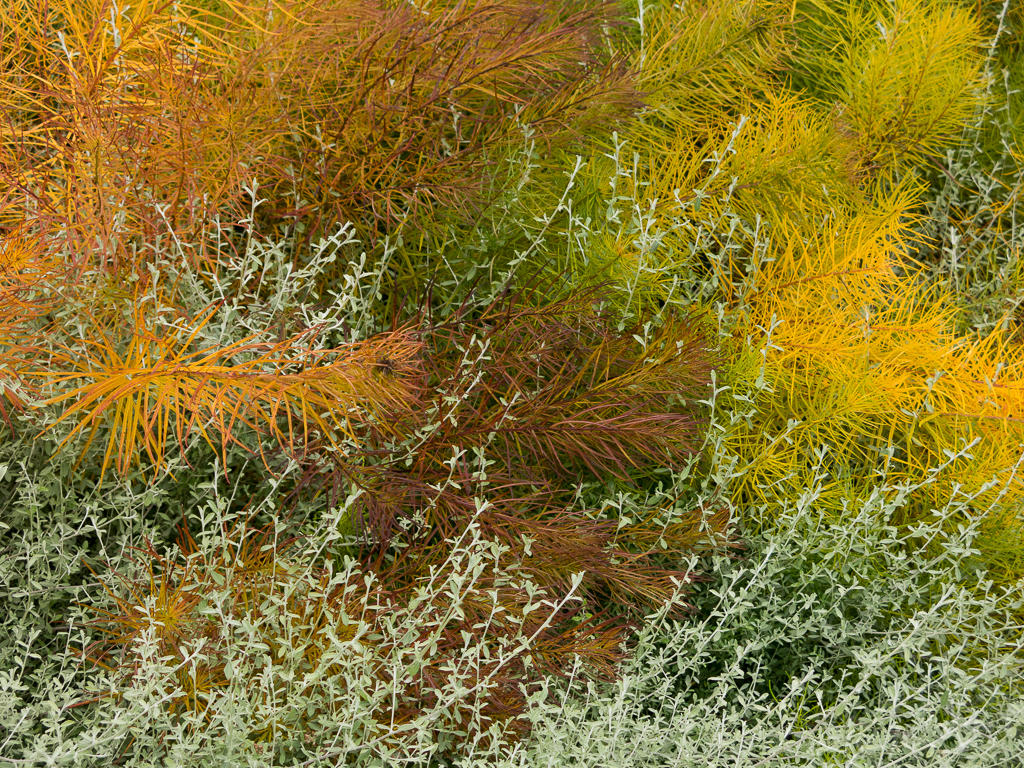

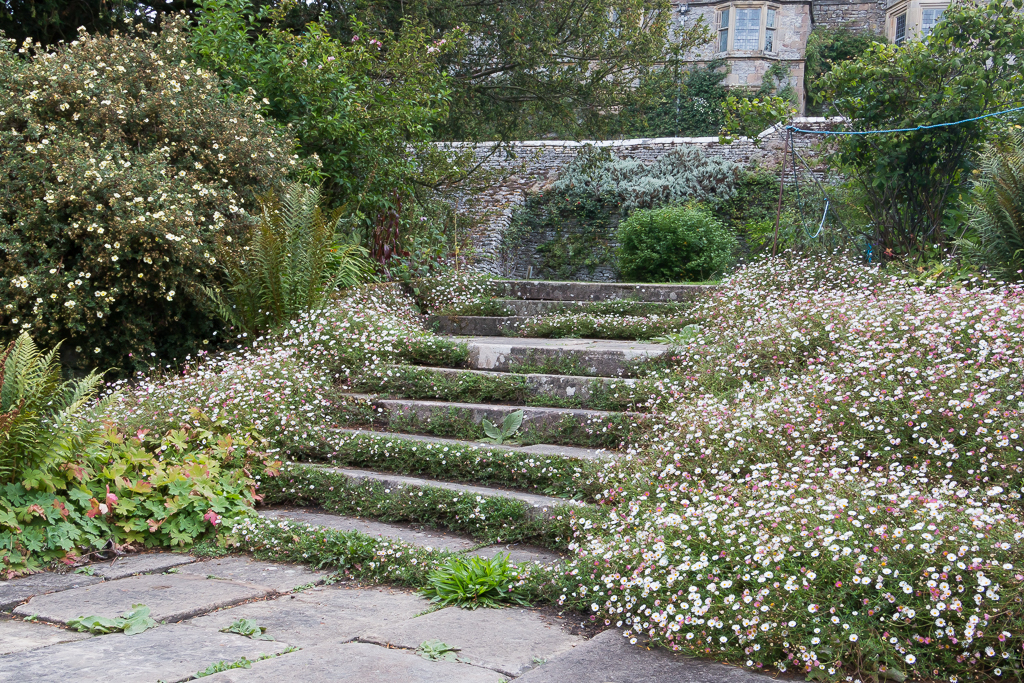


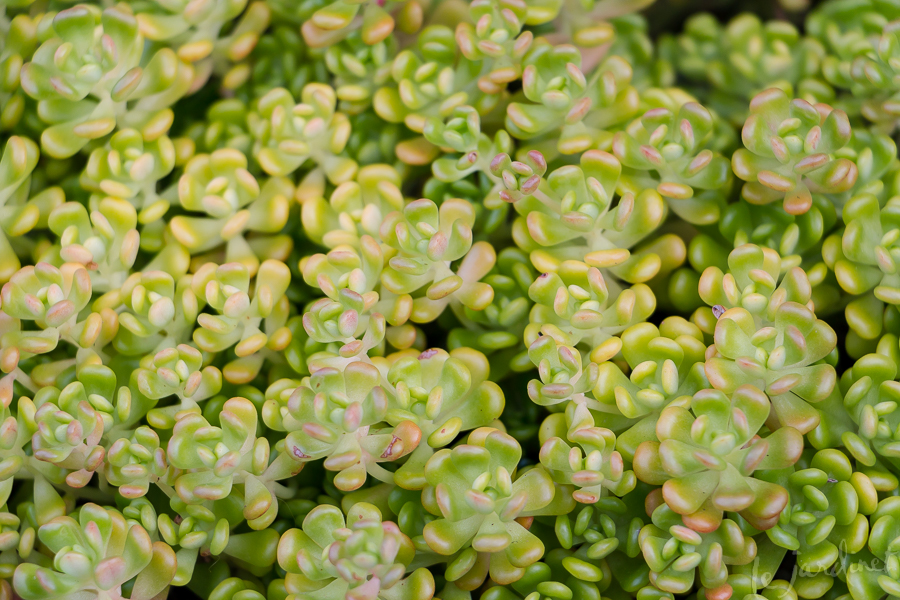
Excellent post, Karen. You've got my wheels turning! Thank you.
Great!